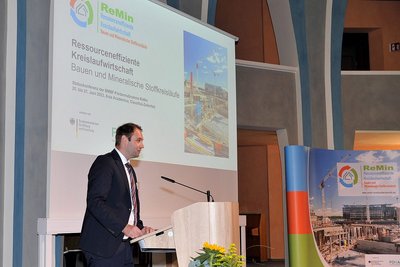Construction with recycled building materials to be further promoted
A total of 75 participants from all over Germany came together in the Clausthal auditorium to discuss the topic of ‘Resource-efficient circular economy - construction and mineral material cycles’.
The German government wants to build 400,000 new homes every year. Recycled building materials are becoming increasingly important in order to drive forward housing construction in this way. In this respect, the conference on ‘Resource-efficient circular economy - construction and mineral material cycles’ (ReMin) held this week in the Aula Academica at Clausthal University of Technology had its finger on the pulse of the times. ReMin is a funding programme to implement the ‘Resource-efficient circular economy’ research concept of the Federal Ministry of Education and Research (BMBF). Around 75 participants from all over Germany met at the two-day event, which was organised by the CUTEC Clausthal Environmental Technology Research Centre (Department of Resource Technology and Systems).
The conference was opened by CUTEC CEO Prof Michael Fischlschweiger: ‘The construction industry, with its high demand for raw materials, is facing major challenges. Against this backdrop, secondary raw materials from construction waste, slag, ash and mining residues can make a significant contribution to security of supply.’ Prof Fischlschweiger described Clausthal University of Technology, with its key theme of circular economy and resource-efficient recycling management, as the ideal location for the conference.
Large amounts of CO₂ can be saved through the circular economy in construction
This was also confirmed by Thomas Bartelt, who is responsible for the ReMin funding programme at the BMBF. ‘Huge amounts of CO₂ can be saved through the circular economy and recycling.’ However, the industry would have to offer good products for this, such as high-quality building materials based on secondary raw materials. Around 82 million tonnes of mineral construction waste are currently produced in Germany every year. Concrete, mixtures of concrete, tiles and ceramics as well as bitumen mixtures account for the largest quantities. Dr Berthold Schäfer (Bundesverband Baustoffe - Steine und Erden) provided information on this in his keynote speech on ‘Material flow-specific approaches for the circular economy - mineral construction and demolition waste’. The cement and concrete industries, for example, could utilise even more recycled building materials in the future.
The 17 joint projects that are being funded as part of ReMin then presented their interim results. In total, the projects are being supported with around 22 million euros from the BMBF and seven million euros from the participating industrial partners. These include two projects led by Clausthal University of Technology (REMINTA and TReMin) and two others involving Clausthal (BAUSEP and REALight). REMINTA, led by Prof Daniel Goldmann, is concerned with the processing and refinement of mineral residues and metals in the tailings ponds of the Rammelsberg ore mine. TReMin is an accompanying research project under the leadership of Prof Fischlschweiger. The aim is to accelerate the transfer of knowledge regarding the circular economy in construction and to publicise the topic to the general public.
Final conference to take place in Goslar
The interim results of all projects are summarised in a 52-page brochure, which Andre Bertram (CUTEC), the coordinator of the accompanying TReMin project, has edited. He was also responsible for the organisation of the conference, which was highly praised by all participants. As a result, the final conference for the ReMin funding programme will also take place in the region in 2024, in Goslar.
CUTEC Chairman Prof. Michael Fischlschweiger (Clausthal University of Technology) opened the conference. Thomas Bartelt from the Federal Ministry of Education and Research and Dr. Berthold Schäfer (German Building Materials Association) then introduced the topic of the circular economy in construction. Photos: Christian Ernst
